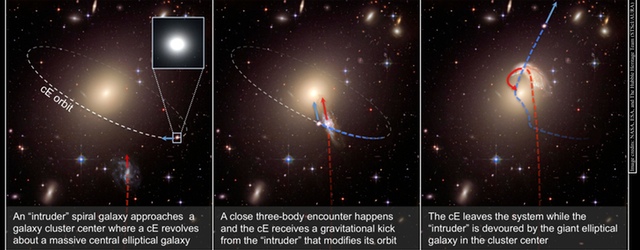The Andromeda galaxy is home to many compact ellipticals. Image: Adam Evans
The universe is a tumultuous place, packed with supernovae, starquakes, and other explosive phenomena. As a result, it is not at all uncommon for stars in the vicinity of colossal cosmic disruptions to be blasted into deep space at dizzying velocities, destined to roam through the interstellar void alone as so-called "runaway stars." According to a study published this week in Science, stars aren't the only celestial objects at risk of being kicked out of their clusters. Apparently, galaxies can also be unceremoniously catapulted into deep space, as evidenced by the discovery of 195 previously unknown compact elliptical galaxies, 11 of which are hurtling through the intergalactic void at velocities of up to six million miles per hour, or 3,000 kilometers per second."These galaxies are facing a lonely future, exiled from the galaxy clusters they used to live in," said lead author Igor Chilingarian, an astronomer at the Harvard-Smithsonian Center for Astrophysics, in a statement.Compact ellipticals are a diminutive class of galaxy, roughly 1,000 times less massive than the Milky Way. Before Chilingarian and his co-author Ivan Zolotukhin, began hunting for these mini-galaxies, only about 30 compact ellipticals were known to astronomers, all of which were firmly ensconced in galaxy clusters.Chilingarian and Zolotukhin dramatically expanded this list by combing through data collected by the Sloan Digital Sky Survey and the GALEX satellite. They weren't surprised to detect a wealth of new compact ellipticals hanging around clusters and larger galaxies. The discovery of the 11 isolated runaway galaxies, however, was an unanticipated twist."The first compact ellipticals were all found in clusters because that's where people were looking," Zolotukhin said in a statement. "We broadened our search, and found the unexpected."To add insult to injury, it appears that these loner galaxies were stripped of many of their stars by the astronomical upsets that first set them on their breakneck trajectories. Chilingarian and Zolotukhin speculate that this process occurs when a much larger companion galaxy, such as the Milky Way, gravitationally plucks an elliptical's stars out like the petals of a flower.
According to a study published this week in Science, stars aren't the only celestial objects at risk of being kicked out of their clusters. Apparently, galaxies can also be unceremoniously catapulted into deep space, as evidenced by the discovery of 195 previously unknown compact elliptical galaxies, 11 of which are hurtling through the intergalactic void at velocities of up to six million miles per hour, or 3,000 kilometers per second."These galaxies are facing a lonely future, exiled from the galaxy clusters they used to live in," said lead author Igor Chilingarian, an astronomer at the Harvard-Smithsonian Center for Astrophysics, in a statement.Compact ellipticals are a diminutive class of galaxy, roughly 1,000 times less massive than the Milky Way. Before Chilingarian and his co-author Ivan Zolotukhin, began hunting for these mini-galaxies, only about 30 compact ellipticals were known to astronomers, all of which were firmly ensconced in galaxy clusters.Chilingarian and Zolotukhin dramatically expanded this list by combing through data collected by the Sloan Digital Sky Survey and the GALEX satellite. They weren't surprised to detect a wealth of new compact ellipticals hanging around clusters and larger galaxies. The discovery of the 11 isolated runaway galaxies, however, was an unanticipated twist."The first compact ellipticals were all found in clusters because that's where people were looking," Zolotukhin said in a statement. "We broadened our search, and found the unexpected."To add insult to injury, it appears that these loner galaxies were stripped of many of their stars by the astronomical upsets that first set them on their breakneck trajectories. Chilingarian and Zolotukhin speculate that this process occurs when a much larger companion galaxy, such as the Milky Way, gravitationally plucks an elliptical's stars out like the petals of a flower. If yet another small galaxy barges onto this scene, the result could be a slingshot effect that launches the elliptical into deep space. That's what the Harvard team believes initiated the flights of these isolated runaway galaxies."We asked ourselves, what else could explain them?" said Chilingarian. "The answer was a classic three-body interaction."This is a great reminder that despite all the environmental catastrophes and extinction events that have occurred on Earth, we are still relatively unscathed in the larger scheme of things. As these 11 new ellipticals demonstrate, the universe is not above stripping galaxies of their stars and chucking them into the depths of intergalactic space at unthinkably rapid speeds. May we never raise its ire.
If yet another small galaxy barges onto this scene, the result could be a slingshot effect that launches the elliptical into deep space. That's what the Harvard team believes initiated the flights of these isolated runaway galaxies."We asked ourselves, what else could explain them?" said Chilingarian. "The answer was a classic three-body interaction."This is a great reminder that despite all the environmental catastrophes and extinction events that have occurred on Earth, we are still relatively unscathed in the larger scheme of things. As these 11 new ellipticals demonstrate, the universe is not above stripping galaxies of their stars and chucking them into the depths of intergalactic space at unthinkably rapid speeds. May we never raise its ire.
Advertisement
